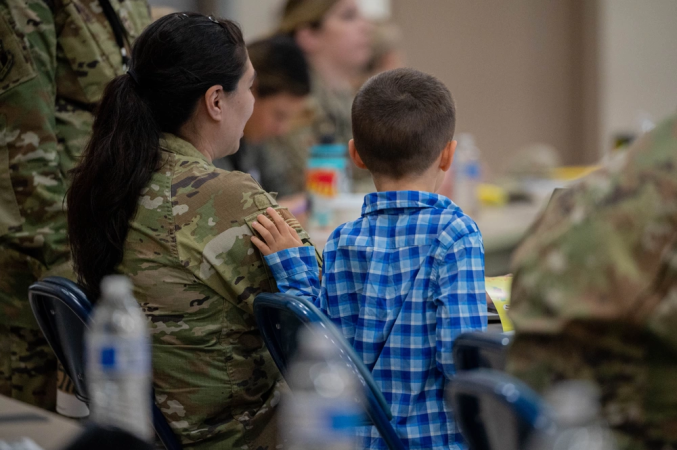Two Air Force Child Development Centers began to turn away some families this month, a move that one military child care expert fears could be a sign of things to come for CDCs across the country.
“What we’re seeing is kind of a perfect storm right now of things not coming together,” Kayla Corbitt, a leading advocate for military child care programs, told Air & Space Forces Magazine.
On March 12, Hill Air Force Base in Utah notified 31 families that their children would be disenrolled from the CDCs there starting March 21 and that Hill’s CDC East facility will close. Base officials tied the news in part to a military civilian hiring freeze that Defense Secretary Pete Hegseth directed to take effect on March 2.
“CDCs traditionally face high turnover, and several recent departures in conjunction with the hiring freeze have reduced the number of supervisors and trainers available,” base officials said in a statement. “Maintaining two open CDCs at current personnel levels would pose an unacceptable risk to the 200 children who remain in care at Hill AFB.”
A follow-up memo from the Pentagon on March 18 exempted schools and child care centers from the freeze, but Hill officials said it will take a while to close its staff shortage.
“The Air Force now has an exemption to hire new CDC staff members. However, the hiring, on-boarding, and training process will take time, and there is no set date for when the CDC East will reopen,” the officials said.
Peterson Space Force Base, Colo., faces a similar issue. On March 24, the CDC there sent a memo asking for eight families to volunteer to enroll their infant children at a civilian partner daycare, since the infant classroom at the Peterson Main CDC had to close due to a staff shortage.
The memo was shared on the popular unofficial Facebook page Air Force amn/nco/snco, and a Space Base Delta 1 spokesperson confirmed its authenticity. The families who volunteer to leave will pay the same rates as the on-base CDC.
“The DOD hiring freeze has slowed caregiver backfill efforts for our Child Development Centers,” the spokesperson said. “The 21st Force Support Squadron will reopen the Peterson SFB infant classroom when staffing levels increase.”
In both cases, the 16-day hiring freeze is just one piece of the puzzle, Corbitt said. The inability to hire staff, however brief, exacerbated a pre-existing staff shortage that CDCs have struggled with for years.
Last May, Sen. Elizabeth Warren (D-Mass), then the chair of the Senate Armed Services personnel subcommittee, blamed a 12,000-children waitlist at worldwide CDCs in part on a 3,900-caregiver shortage.
“That’s more than 12,000 parents struggling to find out how to meet their military obligations when they have small children at home that need care,” she said at a hearing.
Lt. Gen. Caroline Miller, the Air Force’s deputy chief of staff for manpower, personnel, and services, said the Air Force has a 20 percent deficit of child care providers, which affects Airmen’s ability to do their jobs.
“The first thing you do when you get a [permanent change of station] assignment is you look at, if you have children, where are my children going to go? What is the access to child care? How do I get on the list as soon as possible,” she said at the hearing. “I mean, it is mission readiness.”

But solving that staff shortage has proven difficult; military parents work odd hours to meet training requirements, pay is not competitive enough to entice caregivers, and the onboarding process for new child care employees can take months.
Once they’re on staff, caregivers may not stay for long: both Hill and Peterson acknowledged high turnover among CDC staff. Part of that is because many CDC staff are military spouses who have their own children to take care of and who have to move every few years.
“When we talk to spouses or others who have worked at CDCs, they say that it is just too much work, and they’re burning out,” Corbitt said.
Indeed, most CDC, school, and other military youth program directors told the RAND Corporation in a March 20 report that minimal staff support was driving burnout.
The staff shortage may be particularly acute at Peterson and Hill. Thousands of troops and civilians drive high demand at Peterson, which hosts North American Aerospace Command, U.S. Northern Command, Space Base Delta 1, Space Operations Command, and other crucial units.
Hill also hosts a large population as the second-largest Air Force base by population and geographical size, but an abuse scandal at the Hill CDC that first emerged in 2023 has had a chilling effect on hiring, Corbitt said.
CDC hiring freezes are not new, and they often crop up during government shutdowns. But Corbitt pointed to two factors that make hiring CDC staff more difficult this time around. The first is that PCS season, which generally stretches from May to August, is around the corner, which makes it more difficult for spouses to commit to a CDC job.
The second factor is a general lack of confidence in the stability of federal government jobs. The two months since President Donald Trump was inaugurated in January saw thousands of federal employees fired, and while a federal judge ordered 17,000 reinstated, other departments plan to lay off thousands more.
“Nobody really knows what direction we’re going when every day you wake up and there’s a headline about 2,000 or 5,000 or 10,000 people being laid off,” Corbitt said.
Corbitt believes other military CDCs will have to let families go too, since many CDCs have barely enough staff to keep the doors open.
The 2025 National Defense Authorization Act passed in December promised full funding for child care assistance for off-base child care; 180 days of child care for spouses seeking employment (up from 90 days); better pay and benefits for caregivers; and other improvements.
Each of those efforts takes money, though, and a 2025 defense appropriations bill never passed. Corbitt says that hurts lower-income military families first, because they are less likely to be able to afford the off-base child care that they could have utilized through the fee assistance program, for example. They have even fewer options when the CDCs themselves can barely stay open. Meanwhile, higher-income families have less incentive to keep using CDCs if they are so short-staffed.
The CDCs themselves are funded in part by parent fees, which vary based on household income and installation needs. Fewer parents mean less funding, which accelerates a downward spiral, Corbitt explained.
